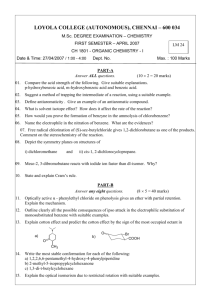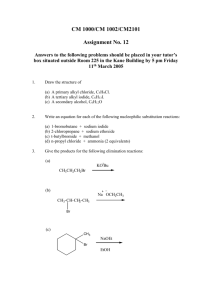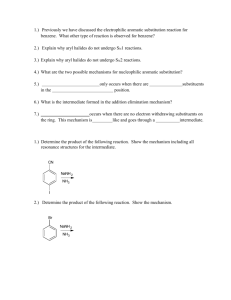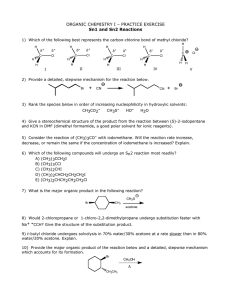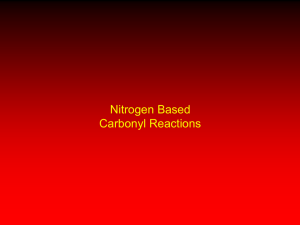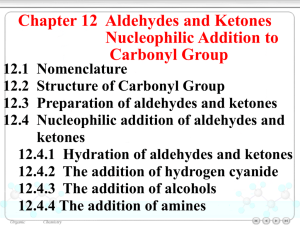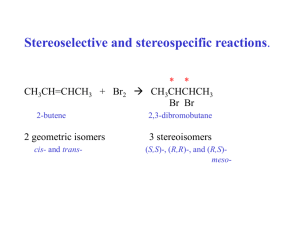CH 1806 - Loyola College
advertisement
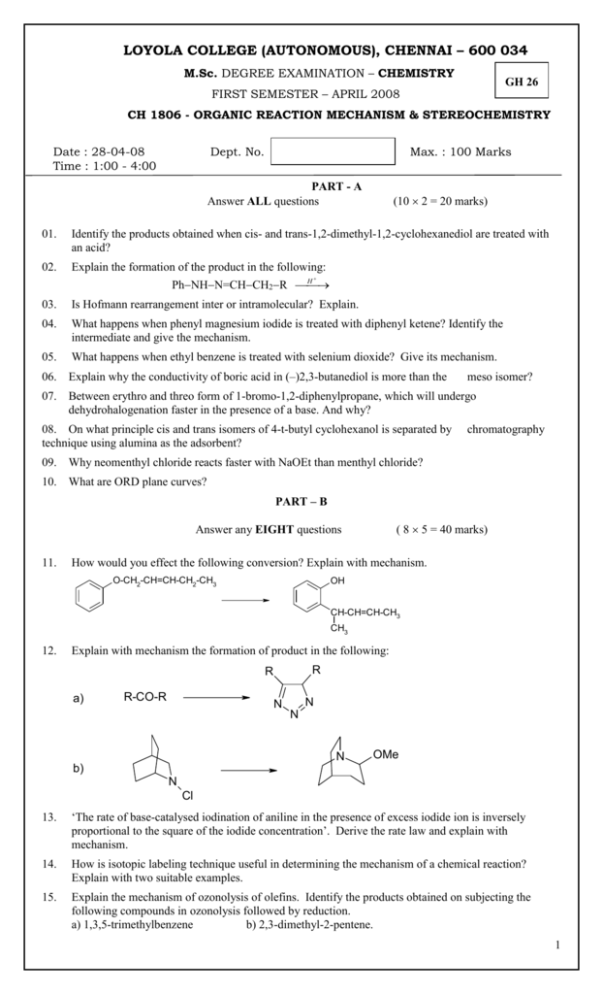
LOYOLA COLLEGE (AUTONOMOUS), CHENNAI – 600 034 M.Sc. DEGREE EXAMINATION – CHEMISTRY GH 26 FIRST SEMESTER – APRIL 2008 CH 1806 - ORGANIC REACTION MECHANISM & STEREOCHEMISTRY Date : 28-04-08 Time : 1:00 - 4:00 Dept. No. Max. : 100 Marks PART - A Answer ALL questions (10 2 = 20 marks) 01. Identify the products obtained when cis- and trans-1,2-dimethyl-1,2-cyclohexanediol are treated with an acid? 02. Explain the formation of the product in the following: H PhNHN=CHCH2R 03. Is Hofmann rearrangement inter or intramolecular? Explain. 04. What happens when phenyl magnesium iodide is treated with diphenyl ketene? Identify the intermediate and give the mechanism. 05. What happens when ethyl benzene is treated with selenium dioxide? Give its mechanism. 06. Explain why the conductivity of boric acid in (–)2,3-butanediol is more than the 07. Between erythro and threo form of 1-bromo-1,2-diphenylpropane, which will undergo dehydrohalogenation faster in the presence of a base. And why? 08. On what principle cis and trans isomers of 4-t-butyl cyclohexanol is separated by technique using alumina as the adsorbent? 09. Why neomenthyl chloride reacts faster with NaOEt than menthyl chloride? 10. What are ORD plane curves? meso isomer? chromatography PART – B ( 8 5 = 40 marks) Answer any EIGHT questions 11. How would you effect the following conversion? Explain with mechanism. O-CH2-CH=CH-CH2-CH3 OH CH-CH=CH-CH3 CH3 12. Explain with mechanism the formation of product in the following: R R a) R-CO-R N N N N OMe b) N Cl 13. ‘The rate of base-catalysed iodination of aniline in the presence of excess iodide ion is inversely proportional to the square of the iodide concentration’. Derive the rate law and explain with mechanism. 14. How is isotopic labeling technique useful in determining the mechanism of a chemical reaction? Explain with two suitable examples. 15. Explain the mechanism of ozonolysis of olefins. Identify the products obtained on subjecting the following compounds in ozonolysis followed by reduction. a) 1,3,5-trimethylbenzene b) 2,3-dimethyl-2-pentene. 1 16. How is addition-elimination reaction mechanism useful in identifying the products in oxidationreduction reactions? Explain with two suitable examples. 17. ‘The solvolysis reactions of 2-phenyl-3-pentyl tosylate and 3-phenyl-2-pentyl tosylate with acetic acid give the same products’. Explain with mechanism. 18. Explain the pyrolysis reaction of xanthates and acetates with suitable examples. 19. Explain Curtin-Hammett principle using the following reaction. *C6H5 C6H5 OH H HONO ? NH2 CH3 20. How is the stable conformation of 1,2-dibromocyclohexane classified by dipole moment measurements? 21. Assign R and S notation for the following compounds a) b) c) H CH3 Br H H F d) H3C H3C NO2 NO2 CHO C H C HO CH3 C CH3 H CH3 OCH3 22. How the major product in an asymmetric induction reaction can be predicted by Cram’s rule and prelog’s with suitable example. PART - C Answer any FOUR questions 23. ( 4 10 = 40 marks) a) How is the determination of order of a reaction helpful in ascertaining the mechanism of organic chemical reactions? Explain with two suitable examples. b) What are consecutive reactions? Derive the kinetics for benzoin condensation and explain the mechanism. 24. Explain the mechanism of the following rearrangements with suitable examples. a) Baeyer-Villiger rearrangement b) Beckmann rearrangement c) Hofmann rearrangement 25. Explain the following with suitable mechanism in oxidation-reduction reactions. a) Hydrogen atom transfer reaction b) Formation of ester intermediate c) Oxidation of alcohols 26. Discuss the stereochemistry of the following reactions: a) Reaction of cis ans trans 2-aminocyclohexanol with HONO. b) Solvolysis reactions of neomenthyltosylate and menthyl tosylate in acetic acid c) Reaction of erythro-3-bromo-2-butanol with HBr 27. Explain the following a) First order asymmetric transformation b) Walden inversion c) Chemical method of racemisation by cation intermediate formation 28. Discuss in detail the stereo selective synthesis of reserpine. 2
